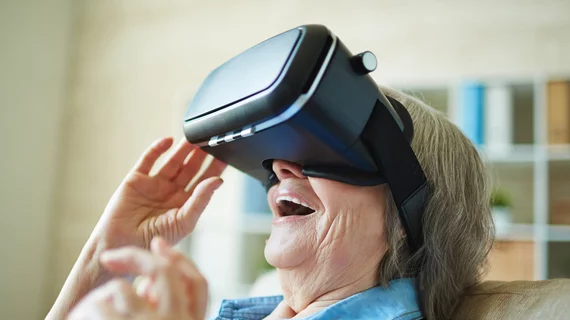Virtual reality during TAVR: Distracting patients linked to key benefits
Virtual reality (VR) can play a valuable role during transcatheter aortic valve replacement (TAVR) procedures, according to a new analysis published in the International Journal of Cardiology.[1] When patients wear VR glasses, it helps time go by more quickly and reduces anxiety.
“To simplify TAVR procedures, local anesthesia alone, without sedation, has been adopted as the standard of care in several institutions for many years,” wrote first author Alexander Lind, MD, head of the TAVR program at Essen University Hospital in Germany, and colleagues. “Post-procedurally, TAVR patients are generally transferred to a cardiology ward with selective admission to the coronary care unit for monitoring. While avoidance of analgesics and sedatives promotes faster procedures, patients' pre- and periprocedural anxiety and periprocedural pain remain unresolved issues. Alternative non-pharmacological strategies are required to reduce pain and anxiety.”
Lind et al. presented VR as one potential way to address anxiety and pain during TAVR.
“VR is an advanced technology that allows for the creation of realistic simulations of a world that can be explored and interacted with freely,” the group wrote.
The analysis included data from 117 high-risk patients with severe symptomatic aortic stenosis (AS) who underwent transfemoral TAVR from June 2022 to March 2023. All patients were treated at the same facility. The mean age was 81.1 years old, and 50.4% of patients were male. Coronary artery disease was confirmed in 64.1% of patients, and 49.6% of patients had a history of atrial fibrillation.
AS severity was determined using transthoracic echocardiography examinations. Procedures were performed without sedation—just local anesthesia—and urinary catheters were avoided to limit complications.
While 50.5% of patients wore VR glasses during TAVR, the remaining 49.5% did not. Patients chose from a list of movie options ahead of the procedure. These films are stored locally on the VR device. There were “no statistically significant” differences between the two groups.
Using the State-Trait Anxiety Inventory (STAI), the study’s authors determined that post-TAVR anxiety was lower among patients in the VR group. In addition, the mean duration of the procedure was lower (60.1 minutes vs. 73.0 minutes) among VR patients, even though the actual procedure length was unchanged.
The use of VR glasses was not associated with any increase in complications.
Virtual reality during TAVR: Can it help with managing pain?
While one of the potential benefits of using VR was to reduce the amount of pain patients experienced during TAVR, that was not seen in this analysis.
“In contrast to previous studies, we could not confirm a reduction in pain in our cohort in the VR group as compared to that in the control group,” the authors wrote. “This could have been due to the sole application of local anesthesia, which shields the patient from the procedure less than does the additional mild sedation used in conscious sedation protocols. However, local anesthesia was sufficient to achieve merely a low sensation of pain in our study, resulting in a lower post-interventional delirium rate than noted in other studies.”
The study’s authors concluded that the use of VR during TAVR is “feasible” and “can lead to improved patient care, fewer pharmacological side effects, and enhanced staff and patient experience during TAVR procedures.”
Read the full study here.

